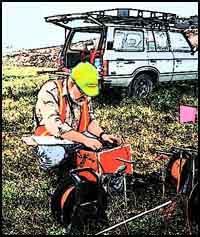

Profiles and soundings may
be obtained simultaneously to yield a 3-dimensional model.
While both EM and resistivity measure apparent ground conductivity, their
response to certain kinds of anomalies differs markedly. EM is very
sensitive to highly conductive media, so a thin, high conductivity layer may
dominate over much thicker, low conductivity layers. Also, if conductivities
are very high, the measurements become non-linear and eventually turn negative.
The resistivity method is less sensitive to thin, high conductivity layers
and can measure even the lowest and highest apparent conductivities.
![]()
email:
consultants@geosphereinc.com
124 north auburn road auburn, mi 48611 tel: (989) 662-6149
fax: (989) 662-7701
copyright ©1990-2007 geosphere inc

